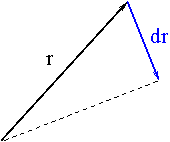In his recent tweet, Sam obtained Kepler’s (second) law simply by using polar coordinates, integrals and conservation law of angular momentum. In this note I discuss basic physics about conservation law of angular momentum and Kepler’s second law as its consequence.
What is angular momentum?
Let $r$ be a vector from a fixed point (called the pivot).

Then the angular momentum is given by $$L=r\times p$$ where $p=mv$ is the linear momentum of the mass $m$. \begin{align*}\frac{dL}{dt}&=\frac{d}{dt}(r\times mv)\\&=\frac{dr}{dt}\times mv+r\times\frac{d(mv)}{dt}\\&=v\times mv+r\times\frac{dp}{dt}\\&=r\times\frac{dp}{dt}\end{align*} since $v\times mv=0$. That is, $\frac{dL}{dt}=r\times F$ and this is called torque. If torque $r\times F=0$ then $L$ is constant. This is conservation law of angular momentum. $r\times F=0$ if and only if $r$ and $F$ are parallel or antiparallel except for the trivial cases $r=0$ or $F=0$. A force that acts exclusively parallel or antiparallel to the position vector is called a central force. That is to say, central forces obey conservation law of angular momentum.
Conservation law of angular momentum implies Kepler’s second law
The area $dA$ spanned by $r$ and $dr$ is $$dA=\frac{1}{2}|r\times dr|$$

Figure 2. The area dA spanned by r and dr.
\begin{align*}\frac{dA}{dt}&=\frac{1}{2}|r\times v|\\&=\frac{1}{2m}|r\times mv|\\&=\frac{1}{2m}|L|\end{align*} $\frac{dA}{dt}$ is the area velocity of the radial vector $r$. It measures how fast area is covered per unit time. For the planetary motion gravitational force is a central force so $L$ is constant which means $\frac{dA}{dt}$ is constant. Hence conservation law of angular momentum implies the second Kepler law: The radial vector $r$ of a planet sweeps equal areas in equal time.
References:
Walter Greiner, Classical Mechanics, Point Particles and Relativity, Springer-Verlag, 2004
